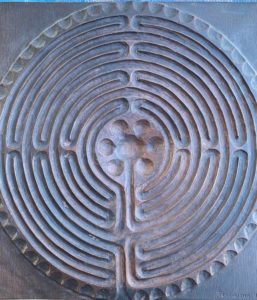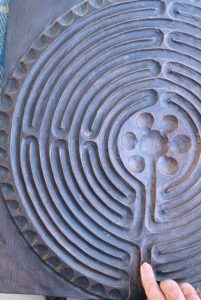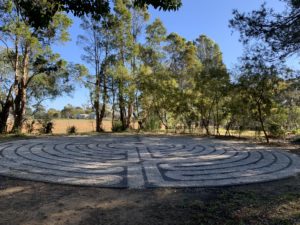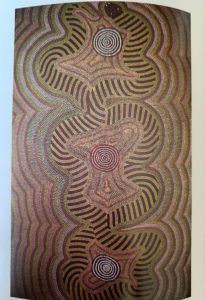
‘I shall show you the path which will take you home and I shall give wings to your minds that can carry you aloft’ Boethius
Walking the Labyrinth
- In a time of social distancing
Recently i got out my hand labyrinth
and with the inspiration from Abbess Christine Valters Paintner
i put aside the time to walk the labyrinth with my left hand.
It was interesting to listen to music and slowly, meditatively take the time with a youtube scene so I felt I was not alone but in a community.
Here is my Hand labyrinth that I bought many years ago from somewhere in the Blue Mountains. Of course I presume these days they can be ordered on line.

- Benedictine Monastery Arcadia NSW.
I have had the opportunity to pray and walk a Labyrinth several times over the past 20 years. I love the journey or significance of walking into the center of the Labyrinth, into the center of my own personal prayer journey, into my heart. When walking the circular path in the silence of prayer and solitude, no words are needed. It is a very healing experience. The walk for me is a prayerful journey into the depth of my heart .
The last time I actually walked a labyrinth was last spring at a day of meditation at St. Benedict’s Monastery at Arcadia.

Driving out to the Monastery on the edge of the city is always a centring experience . I arrived early so that I could walk the labyrinth before the people arrived for the day of meditation. It was crisp, clear day and breathing fresh country and the sounds surrounding mewas only a zephyr of a breeze, and bird song. The kookaburras gathered 5 of them, moved between trees and branches and laughed intermittently. They made me smile and reminded me not to take life too seriously.
Every labyrinth experience is difference. Besides the elegant geometry of which there are several there is different ground textures different sounds being inside ot outside etc. as you walk The one at Arcadia is the Chartre model as the finger labyrinth is but it is made with white gravel stones that have a crunch as you take each step .
- The Chartre Cathedral Labyrinth
In this world of pilgrimage one of the most famous labyrinths is the one in Chartre Cathedral. I have been there when it is covered by chairs and not to be walked because whoever was in charge felt people were coming to do that rather then pray and one time they take the chairs away at 5 for the eager ones still waiting to walk.
My friends have been there in the evening where my friend played the cello while people walked with candles all around it. How wonderful that would be. When I walked tI marveled at the stone all smooth with a thousand years of walking this pilgrimage some for penance have done it on their knees. I walked in in a quiet reflective way with a question. I cant remember what the question was now (It was 40 years ago) and the answer was not important.
There is a phrase solvitur ambulando—it is made by walking. I’ll admit, while the phrase resonates, I don’t understood it fully, and perhaps that’s because I am trying to understand it with words. But after walking the labyrinth slowly I am finding the words ‘it is made by walking whispering, “solvitur ambulando,” and my soul echoing, “it is made by walking,” and I know the phrase is true.
I have a book called Labyrinths: Ancient paths of wisdom and peace, by Virginia Westbury and great photography by Cindy Pavlinac, which I picked up for a few dollars. There is so many interesting things to read and learn.
* An Indigenous Story
One new fact from this book is of our own First Nation Peoples .

Gagadju White Lady Kakadu National Park
There is a reluctance to say too much here for I can find no reference to credit the photos of the two Indigenous works. I have been with an Indigenous Guide to study cave painting up near Kakadu and these two paintings take my breath away.
Studies have found that ancient peoples employed for their story telling shapes such as spirals amd concentric circles to denote sacred places and being associated with their ‘Dreaming’ which today some same relates to their pholosophy their creative stories. Frequently they drew these figures on sand or rock and today on canvas as a way of relating their stories

In this Aboriginal painting it depicts the story of a huge snake called
‘Rainbow Serpent ‘ which according to the stories gave birth to all creatures . This snake is portrayed curled up in a spiral or around a series of labyrinth-like concentric circles. Serpents feature prominently in Greek mythology too, as symbols of immortality and prophecy.
‘Love has taken away my practice and filled me with poetry ‘ Rumi
A few web sights I have found is
veriditas.org and
asacredjourney.net
